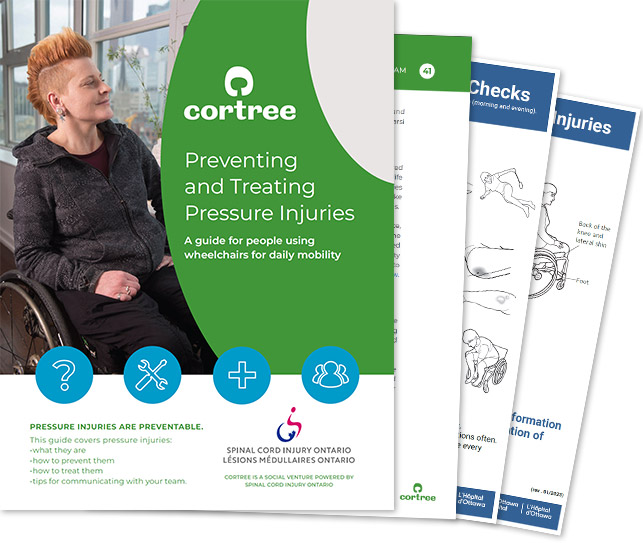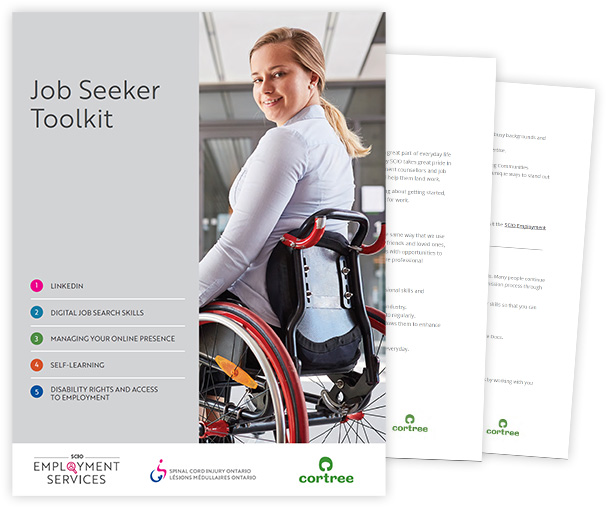
Pain Control
Cortree Appreciates the Importance of Pain Control for Maintaining Quality of Life
This Page Will Cover:
If pain is affecting your life, you are not alone. Almost 20 per cent of Canadians live with chronic pain. Among people with neurological conditions the prevalence is closer to 40 per cent.
If you are experiencing chronic pain you know it can be hard to live with and difficult to treat. You may have questions like: Why am I in pain? Am I getting worse? When will it go away? What if it never goes away? Each flare up of pain can start a cycle of negative thoughts, symptoms and behaviours again. It can be really hard to feel optimistic about the future.
Getting your pain under control will take time, trial and error and the support of your health care team and family. Our years of experience working with people with spinal cord injuries and other mobility disabilities has given Cortree a specialized perspective on managing chronic pain.
The purpose of this page is to share some ideas and resources to help you get started.
The Different Types of Pain
There are different kinds of pain and you may be experiencing some or all of them.
Musculoskeletal pain is usually dull or aching, and it mostly happens during certain movements and positions. Musculoskeletal pain is due to changes in bone, tendons or joints.
Visceral pain comes from internal organs like the stomach or bladder. It can be hard to know where visceral pain is coming from. Usually it feels dull or tender, like cramping, and is caused by problems like constipation or bladder infections.
Neuropathic pain is often a burning, tingling, pins and needles, or electric shock feeling that can be felt anywhere in the body. Neuropathic pain can happen spontaneously, or be caused by things that don’t normally cause pain like the pressure of a child sitting on your lap. It can be felt far away from where the damaged nerve is, for example tingling in your fingers when the nerve problem is in your neck.
Acute pain is experienced right after an injury and is directly related to soft tissue damage. It arises quickly and can be severe but usually lasts a short period of time and is relatively straightforward to treat.
Chronic pain is pain that lasts for more than six months and it changes how pain is experienced in the nervous system. It lasts for more than six months and it changes how pain is experienced in the nervous system.
What is the Definition of Pain Control?
Pain is complex and pain control can be an ongoing, daily obstacle for those who live with chronic or severe pain.
Pain is a personal experience. The only way to measure pain is to ask you about it. This can add to the feeling of isolation for people living with pain. This means the definition of pain control can vary depending on each individual’s experience.
Pain can be turned up or down by other nerve signals by the brain and the body. This means your pain can feel worse if you are stressed, or if you have an infection like a urinary tract infection. On the other hand, your pain may not bother you as much when you are distracted by an activity you enjoy.
Pain control is an important part of a wider pain management strategy. Ultimately, the goal of pain control is to improve your quality of life, and allow you to carry out daily activities more easily. Different medications (depending on the type of your pain) and therapies can help you better control your pain, but taking your pain away completely is not usually realistic. Your doctor will help to develop a pain control strategy that may work for you. Your doctor may also ask for help from other specialists and healthcare providers (nurses, therapists, psychologists and social workers) who can help develop the best plan for you.
Pain Control After Surgery
Learning to control pain after surgery is extremely important both for providing comfort during recovery, and because it has some potential health benefits.
When someone who’s recovering from surgery is kept comfortable, it assists them in healing. It can also reduce the risks of experiencing certain complications after surgery, like blood clots or pneumonia.
Providing pain control after surgery will also allow you to perform certain tasks that may be asked of you to facilitate the healing process, such as deep breathing exercises and physical therapy.
In many cases, doctors and nurses who are helping you with your recovery will ask you to rate the scale of your pain periodically. This is so they can make adjustments to their pain control techniques, and check to make sure your treatments are effective.

Some Useful Pain Control Techniques
Finding the right pain control techniques often involves trial and error to find what works best for you. It is important to talk with your health care team about your preferences, options, and the potential risks, benefits and side effects of any treatments you are considering.
When most people think about pain control, the first thought that comes to mind are pain medications. While these are important tools for helping patients to gain control over their pain, they’re far from the only pain control techniques.
Physical treatments like exercise, massage, manual therapy, acupuncture and heat can also help with pain control. For people with spinal cord injuries, a treatment called TENS or Transcutaneous Electrical Nerve Stimulation may help reduce some pain after spinal cord injury.
Surgery for pain control is not common and is usually only considered when other treatments haven’t worked.
Psychological and mind-body therapies can help to address the contributing factors to pain – the things that dial your pain up and down. Some examples include Cognitive Behavioural Therapy, Biofeedback, Visual Imagery and Hypnosis.
Treatments for substance use, depression, anxiety and post-traumatic stress disorder may also play a role in pain management. Among people with chronic pain mindfulness interventions have been shown to decrease anxiety, depression and distress, as well as enhance quality of life. Using meditation for pain control is a technique that anyone can try, without requiring prescriptions or medical assistance. Meditation can be done from the comfort of your home, as well; making it a very convenient option, if it works for you.
You can find more information on techniques for providing chronic pain relief here.

Chronic Pain Clinics & Other Helpful Resources
Chronic pain clinics, also called pain management clinics, are medical facilities that specialize in managing pain. They may teach pain control techniques, assist with medications/injections, and focus on helping you manage chronic pain. If you think this service would benefit you, we encourage you to speak with your doctor about pain management clinics in your area. Other programs and specialists may also provide assistance for this if you are living with a disability and chronic pain. Your doctor can assist you with finding a program that is right for you.
Cortree offers a number of educational series that can teach you how to make life more inclusive and accessible if you’re living with a disability or chronic pain. We also provide a learning plan series on living with chronic pain, which could be invaluable for you in learning pain control techniques.
Learning to Manage Your Pain
Chronic pain can be as challenging emotionally as it is physically, and we want you to know that Cortree is here to help. Quality of life is one of the most important things that must be considered when someone is learning to control their pain.
This is no small task. You or your loved ones may need assistance in creating a pain management strategy that will be effective for your situation.
Sign-up today and you’ll get access to all our helpful learning plans and courses. With these tools, you can begin learning techniques to assist with managing your pain and start enjoying life again.

